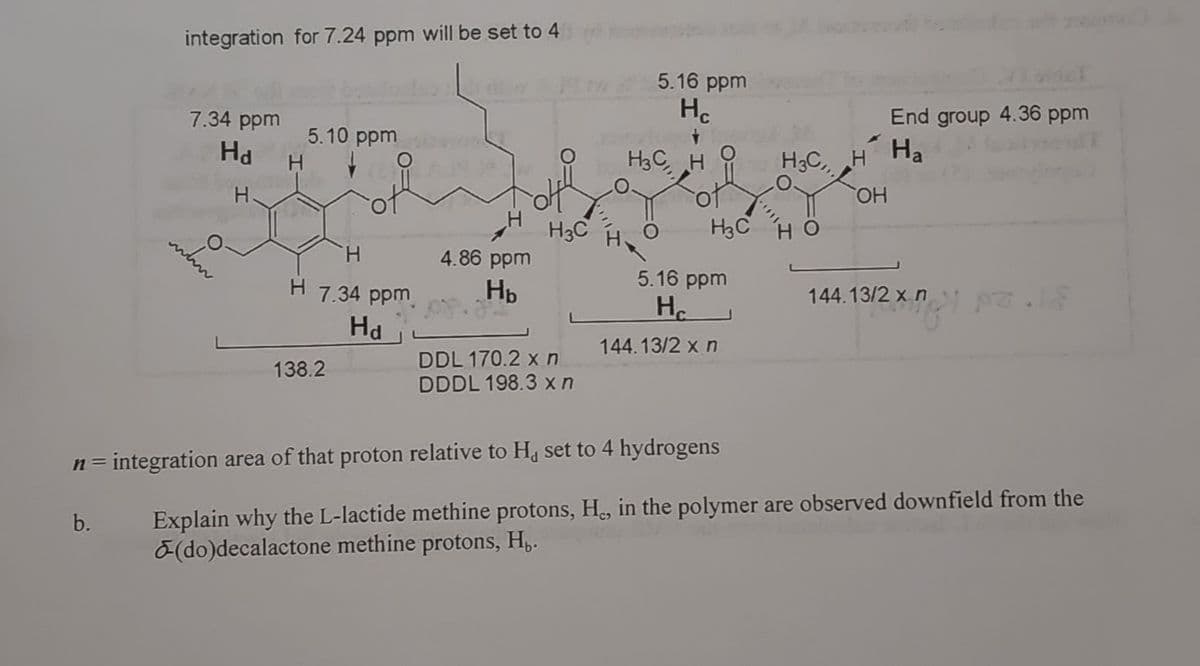integration for 7.24 ppm will be set to 4 5.16 ppm H. End group 4.36 ppm На 7.34 ppm 5.10 ppm На H3C H H3C, H. HO, H3C H3C 4.86 ppm H. 5.16 ppm H 7.34 ppm Hp 144.13/2 x nN На 144.13/2 x n DDL 170.2 x n DDDL 198.3 xn 138.2 n= integration area of that proton relative to H, set to 4 hydrogens Explain why the L-lactide methine protons, He, in the polymer are observed downfield from the E(do)decalactone methine protons, H,. b.
integration for 7.24 ppm will be set to 4 5.16 ppm H. End group 4.36 ppm На 7.34 ppm 5.10 ppm На H3C H H3C, H. HO, H3C H3C 4.86 ppm H. 5.16 ppm H 7.34 ppm Hp 144.13/2 x nN На 144.13/2 x n DDL 170.2 x n DDDL 198.3 xn 138.2 n= integration area of that proton relative to H, set to 4 hydrogens Explain why the L-lactide methine protons, He, in the polymer are observed downfield from the E(do)decalactone methine protons, H,. b.
Principles of Instrumental Analysis
7th Edition
ISBN:9781305577213
Author:Douglas A. Skoog, F. James Holler, Stanley R. Crouch
Publisher:Douglas A. Skoog, F. James Holler, Stanley R. Crouch
Chapter29: Supercritical Fluid Chromatography And Extraction
Section: Chapter Questions
Problem 29.11QAP
Related questions
Question

Transcribed Image Text:integration for 7.24 ppm will be set to 4
5.16 ppm
7.34 ppm
H.
End group 4.36 ppm
5.10 ppm
H
На
H3C H
H3C
HHa
H.
HO.
H3C H
H3C
4.86 ppm
H.
5.16 ppm
H 7.34 ppm
Hp
144.13/2 xn
H.
На
144.13/2 x n
DDL 170.2 x n
DDDL 198.3 x n
138.2
n= integration area of that proton relative to H set to 4 hydrogens
Explain why the L-lactide methine protons, H, in the polymer are observed downfield from the
(do)decalactone methine protons, H,.
b.
Expert Solution
This question has been solved!
Explore an expertly crafted, step-by-step solution for a thorough understanding of key concepts.
This is a popular solution!
Trending now
This is a popular solution!
Step by step
Solved in 2 steps with 1 images

Knowledge Booster
Learn more about
Need a deep-dive on the concept behind this application? Look no further. Learn more about this topic, chemistry and related others by exploring similar questions and additional content below.Recommended textbooks for you

Principles of Instrumental Analysis
Chemistry
ISBN:
9781305577213
Author:
Douglas A. Skoog, F. James Holler, Stanley R. Crouch
Publisher:
Cengage Learning

Principles of Instrumental Analysis
Chemistry
ISBN:
9781305577213
Author:
Douglas A. Skoog, F. James Holler, Stanley R. Crouch
Publisher:
Cengage Learning